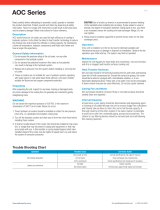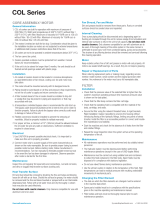All system wiring is performed at the factory if a control panel is supplied and installed on the skid. Check area
classification to ensure all electrical enclosures comply with code. Required customer wiring is minimal, but
should be done by a qualified electrician in compliance with OSHA, National Electric Code and any other
applicable local electrical code concerning switches, fused disconnects, etc. DEKKER includes a wiring diagram
in the control panel for use by the installer. DEKKER recommends a main disconnect switch be fitted between
the vacuum system and the incoming power.
After the electrical wiring connections are completed, check the incoming voltage to make sure the incoming
voltage is the same as the vacuum system voltage. Line voltage should be within the voltage tolerance as
specified on the motor or to local code. Check the system for proper motor rotation. The direction of
rotation is marked by an arrow on the motor or pump housing. Jog the motor by pressing the ON button and
then the OFF button. If the rotation is incorrect, switch any two of the three main power leads (three phase
power) on the contactor inside the control panel. Failure to do so could result in serious equipment damage.
WARNING: Install, ground, and maintain equipment in accordance with the National Electrical
Code and all applicable federal, state and local codes.
WARNING: For NFPA 99 hospital and generator applications, please shut down the vacuum
pumps prior to generator testing. The rapid stop and restart may cause damage to the pump
and/or motor and cause damage to electrical panel and related components.
Pipe Connection and Sizing
Before installation, remove all protective inserts on the pump suction and discharge. Piping connected to the
system must be installed without imposing any strain on the system components. Improperly installed piping
can result in misalignment, general operating problems and pump failure. Use flexible connectors where
necessary. Piping must be cleaned of debris before installation.
DEKKER recommends CPVC piping as discharge temps may exceed +170°F. CPVC is rated for 200°F max, and
PVC is only rated for 140°F max. Schedule 40 PVC piping is generally acceptable for the inlet connections.
Inlet Piping
Note: Install a temporary screen at the pump inlet flange at first start-up to protect the unit against carryover
of pipe debris and welding slag. The screen must be removed after the initial run-in period.
Inlet piping should be at least the size of the pump inlet. Install the system as close as possible to the process to
minimize losses due to the length of the suction line. If the system has to be installed further away from the
process, be sure the inlet piping is properly sized to minimize the overall line pressure drop. For more
information consult your authorized dealer or contact the factory.
Pump systems operating in parallel on a common manifold must each have a manual or automatic shut-off valve
and a suitable check valve installed in the suction line close to the pump suction flange. This allows each
individual system to be isolated when it is not in operation. The line size of the manifold should be a minimum
equal to the sum of the individual system pipe areas.
Systems are supplied with an inlet check valve as standard. This valve is installed close to the pump suction
flange to prevent back flow of process gas and seal fluid when the pump is stopped.
If the inlet gas pumped contains dust or foreign particles, a suitable 5 micron (or finer) inlet filter should be
installed at the inlet port. For more information consult your authorized dealer or the factory.
If the possibility exists that the pump inlet can become closed during operation it will be essential to install
some type of vacuum relief valve (anti-cavitation valve) so that air can enter the pump inlet. Never run a pump
with a closed suction. This causes hydraulic knock / cavitation and can damage the pump.






















